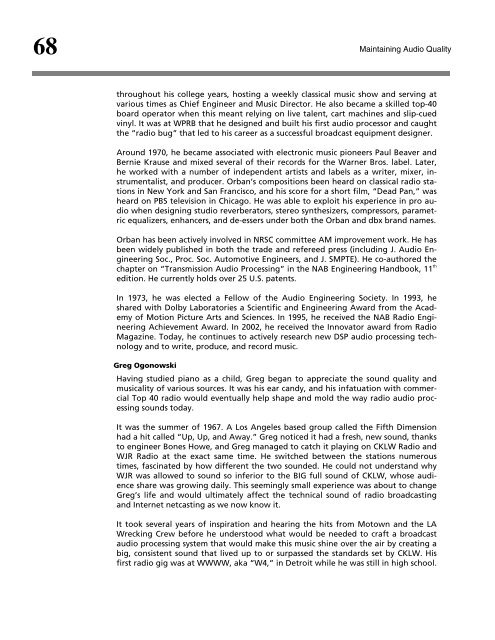Maintaining Audio Quality in the Broadcast Facility 2011 - Orban
Maintaining Audio Quality in the Broadcast Facility 2011 - Orban
Maintaining Audio Quality in the Broadcast Facility 2011 - Orban
You also want an ePaper? Increase the reach of your titles
YUMPU automatically turns print PDFs into web optimized ePapers that Google loves.
68<br />
<strong>Ma<strong>in</strong>ta<strong>in</strong><strong>in</strong>g</strong> <strong>Audio</strong> <strong>Quality</strong><br />
throughout his college years, host<strong>in</strong>g a weekly classical music show and serv<strong>in</strong>g at<br />
various times as Chief Eng<strong>in</strong>eer and Music Director. He also became a skilled top-40<br />
board operator when this meant rely<strong>in</strong>g on live talent, cart mach<strong>in</strong>es and slip-cued<br />
v<strong>in</strong>yl. It was at WPRB that he designed and built his first audio processor and caught<br />
<strong>the</strong> “radio bug” that led to his career as a successful broadcast equipment designer.<br />
Around 1970, he became associated with electronic music pioneers Paul Beaver and<br />
Bernie Krause and mixed several of <strong>the</strong>ir records for <strong>the</strong> Warner Bros. label. Later,<br />
he worked with a number of <strong>in</strong>dependent artists and labels as a writer, mixer, <strong>in</strong>strumentalist,<br />
and producer. <strong>Orban</strong>’s compositions been heard on classical radio stations<br />
<strong>in</strong> New York and San Francisco, and his score for a short film, “Dead Pan,” was<br />
heard on PBS television <strong>in</strong> Chicago. He was able to exploit his experience <strong>in</strong> pro audio<br />
when design<strong>in</strong>g studio reverberators, stereo syn<strong>the</strong>sizers, compressors, parametric<br />
equalizers, enhancers, and de-essers under both <strong>the</strong> <strong>Orban</strong> and dbx brand names.<br />
<strong>Orban</strong> has been actively <strong>in</strong>volved <strong>in</strong> NRSC committee AM improvement work. He has<br />
been widely published <strong>in</strong> both <strong>the</strong> trade and refereed press (<strong>in</strong>clud<strong>in</strong>g J. <strong>Audio</strong> Eng<strong>in</strong>eer<strong>in</strong>g<br />
Soc., Proc. Soc. Automotive Eng<strong>in</strong>eers, and J. SMPTE). He co-authored <strong>the</strong><br />
chapter on “Transmission <strong>Audio</strong> Process<strong>in</strong>g” <strong>in</strong> <strong>the</strong> NAB Eng<strong>in</strong>eer<strong>in</strong>g Handbook, 11 th<br />
edition. He currently holds over 25 U.S. patents.<br />
In 1973, he was elected a Fellow of <strong>the</strong> <strong>Audio</strong> Eng<strong>in</strong>eer<strong>in</strong>g Society. In 1993, he<br />
shared with Dolby Laboratories a Scientific and Eng<strong>in</strong>eer<strong>in</strong>g Award from <strong>the</strong> Academy<br />
of Motion Picture Arts and Sciences. In 1995, he received <strong>the</strong> NAB Radio Eng<strong>in</strong>eer<strong>in</strong>g<br />
Achievement Award. In 2002, he received <strong>the</strong> Innovator award from Radio<br />
Magaz<strong>in</strong>e. Today, he cont<strong>in</strong>ues to actively research new DSP audio process<strong>in</strong>g technology<br />
and to write, produce, and record music.<br />
Greg Ogonowski<br />
Hav<strong>in</strong>g studied piano as a child, Greg began to appreciate <strong>the</strong> sound quality and<br />
musicality of various sources. It was his ear candy, and his <strong>in</strong>fatuation with commercial<br />
Top 40 radio would eventually help shape and mold <strong>the</strong> way radio audio process<strong>in</strong>g<br />
sounds today.<br />
It was <strong>the</strong> summer of 1967. A Los Angeles based group called <strong>the</strong> Fifth Dimension<br />
had a hit called “Up, Up, and Away.” Greg noticed it had a fresh, new sound, thanks<br />
to eng<strong>in</strong>eer Bones Howe, and Greg managed to catch it play<strong>in</strong>g on CKLW Radio and<br />
WJR Radio at <strong>the</strong> exact same time. He switched between <strong>the</strong> stations numerous<br />
times, fasc<strong>in</strong>ated by how different <strong>the</strong> two sounded. He could not understand why<br />
WJR was allowed to sound so <strong>in</strong>ferior to <strong>the</strong> BIG full sound of CKLW, whose audience<br />
share was grow<strong>in</strong>g daily. This seem<strong>in</strong>gly small experience was about to change<br />
Greg’s life and would ultimately affect <strong>the</strong> technical sound of radio broadcast<strong>in</strong>g<br />
and Internet netcast<strong>in</strong>g as we now know it.<br />
It took several years of <strong>in</strong>spiration and hear<strong>in</strong>g <strong>the</strong> hits from Motown and <strong>the</strong> LA<br />
Wreck<strong>in</strong>g Crew before he understood what would be needed to craft a broadcast<br />
audio process<strong>in</strong>g system that would make this music sh<strong>in</strong>e over <strong>the</strong> air by creat<strong>in</strong>g a<br />
big, consistent sound that lived up to or surpassed <strong>the</strong> standards set by CKLW. His<br />
first radio gig was at WWWW, aka “W4,” <strong>in</strong> Detroit while he was still <strong>in</strong> high school.



![[PDF] Using the ITU BS.1770-2 and CBS Loudness Meters ... - Orban](https://img.yumpu.com/50629372/1/190x245/pdf-using-the-itu-bs1770-2-and-cbs-loudness-meters-orban.jpg?quality=85)






![[PDF] Optimod-FM Feature Comparison - Orban](https://img.yumpu.com/41741615/1/190x245/pdf-optimod-fm-feature-comparison-orban.jpg?quality=85)






